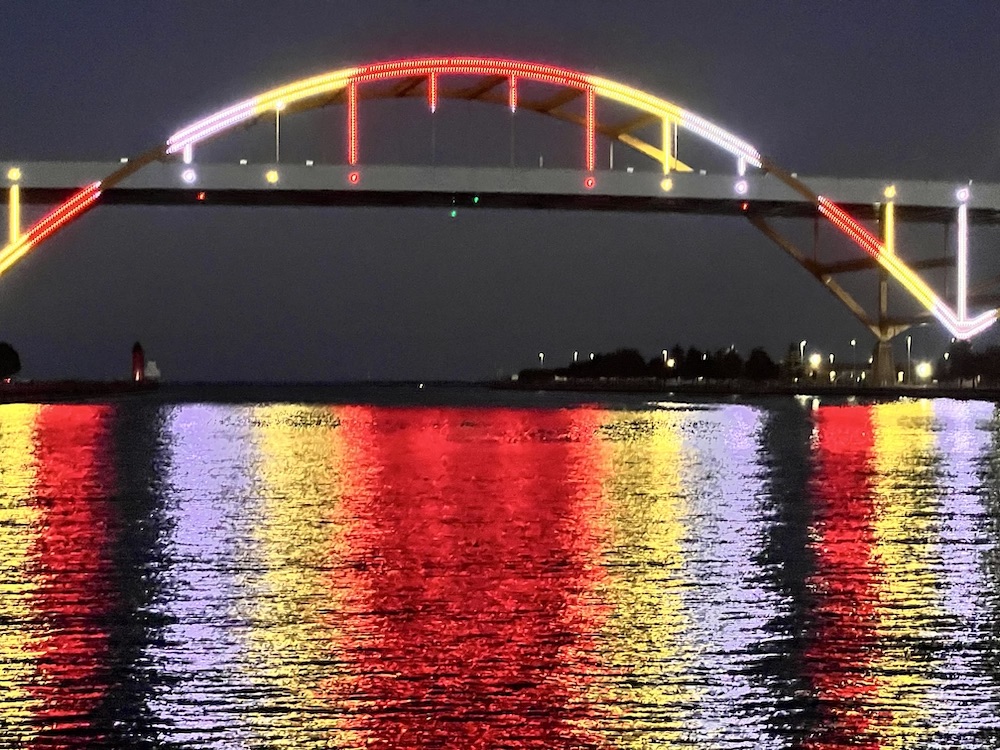
- Details
- By Darren Thompson
MILWAUKEE— A bridge on Milwaukee’s lakefront lit up yesterday evening in the colors of the medicine wheel—black, white, yellow and red—to recognize and celebrate Indigenous Peoples’ Day.
The light show took place at the Riverfront Launching Site with Milwaukee Mayor Cavalier Johnson, Milwaukee County Executive David Crowley, Ho-Chunk Nation Traditional Chief Clayton Winneshiek, and nearly a hundred other participants. The ceremony featured traditional song and dance, and a reading of Milwaukee County’s proclamation of Indigenous Peoples Day.
“Indigenous Peoples Day is more than legislation,” Johnson said. “When we think about Milwaukee, we can’t help but think about Native people. We can’t help but think that we’re on Native land.”
Milwaukee’s name comes from Indigenous languages. According to some, the name derives from the Algonquian word millioke, which means “the good land”, or from the Anishinaabemowin (the language of the Ojibwe, Potawatomi and Odawa) word minwaking, which means the “gathering place (by the water).”
“Native people have had a direct influence on Milwaukee,” Johnson said.
The three rivers that flow through the city are the Milwaukee, Kinnickinnic, and the Menominee rivers, which are all named by Indigenous languages. The names of several surrounding townships—including Wauwatosa, Muskego and Pewaukee—come from Indigenous words.
In 2017, Milwaukee County Executive Scott Abele declared the second Monday of October as Indigenous Peoples Day. In 2019, Milwaukee’s then Mayor Tom Barrett also signed a proclamation declaring the second Monday of October as Indigenous Peoples’ Day. In the same year, the Milwaukee County Board of Supervisors passed a resolution that changed the name of Columbus Park to Indigenous Peoples’ Park.
Crowley, the Milwaukee county executive, read from a proclamation: “Milwaukee County recognizes that the land it is built upon has been home to Indigenous peoples since time immemorial, and it's the ancestral land of the Ho-Chunk Nation, the Forest County Potawatomi, and the Menominee Nation,” he said. “The purpose of Indigenous Peoples Day is to commemorate and celebrate Indigenous peoples as they continue to thrive despite 500 years of genocide, colonization, and political and religious and cultural repression.”
The lighting of the bridge in the colors of the medicine wheel is a first, Light the Hoan spokesperson Micheal Holstad told Native News Online. The organization was founded nearly four years ago, to light up and bring color to Milwaukee’s most iconic bridge. To date, they have raised $3.8 million in private funding to light up the west side of the bridge, which faces towards the city. Organizers are currently raising funds to light the east side, which faces towards Lake Michigan.
The bridge was first lit on October 22, 2020 and has been lit every night since, featuring various colors and sequences.
“It’s the people’s lights,” Holstad told Native News Online. “We light for all things, for causes such as cancer to homelessness.”
The dedication comes as Indigenous Biz Con is launching what hopes to be an annual conference that brings people together to highlight Indigenous businesses. The conference features a keynote presentation on Tuesday by Sterlin Harjo, co-creator and writer of “Reservation Dogs”, panel discussions by former Director of the Office of Economic Impact and Diversity at the United States Department of Energy James Campos, and many others.
“There is so much that has happened over the years, starting way back, and people are forgetting their way of life,” said Ho-Chunk Nation Traditional Chief Clayton Winneshiek during Monday’s celebration of Indigenous Peoples Day. “What these men are doing, bringing people together, to recognize us brings us hope.”
Wisconsin Governor Tony Evers first recognized the second Monday in October as Indigenous Peoples Day when he signed Executive Order #50. This year marks the fourth year in a row that Wisconsin has recognized and celebrated Indigenous Peoples Day. Last year, Gov. Evers signed Executive Order #136, which issued a formal acknowledgement and apology for Wisconsin’s historical role in Indian boarding schools.
Wisconsin has eleven federally recognized tribes and one federally unrecognized nation, including the federally recognized Bad River Band of Lake Superior Chippewa, Forest County Potawatomi, Ho-Chunk Nation, Lac Courte Oreilles Band of Lake Superior Chippewa, Lac du Flambeau Band of Lake Superior Chippewa Indians, Menominee Indian Tribe of Wisconsin, Oneida Nation of Wisconsin, Red Cliff Band of Lake Superior Chippewa, Sokaogon Chippewa Community Mole Lake Band of Lake Superior Chippewa, St. Croix Chippewa Tribe of Wisconsin, Stockbridge-Munsee Mohican Tribe, and the state-recognized Brothertown Indian Nation.
Editor's Note: This story has been updated to correct the year the Hoan bridge was first lit up as 2020, not 2022. The story has also been updated to clarify the recognition status of the Brothertown Indian Nation.
More Stories Like This
Native News Weekly (August 25, 2024): D.C. BriefsUS Presidents in Their Own Words Concerning American Indians
Happy New Year 2026 from Native News Online
Next on Native Bidaské: Covering Indian Country: Lessons from 2025 & the Road Ahead
The Stories That Started to Define Cultivating Culture in 2025
Help us defend tribal sovereignty.
At Native News Online, our mission is rooted in telling the stories that strengthen sovereignty and uplift Indigenous voices — not just at year’s end, but every single day.
Because of your generosity last year, we were able to keep our reporters on the ground in tribal communities, at national gatherings and in the halls of Congress — covering the issues that matter most to Indian Country: sovereignty, culture, education, health and economic opportunity.
That support sustained us through a tough year in 2025. Now, as we look to the year ahead, we need your help right now to ensure warrior journalism remains strong — reporting that defends tribal sovereignty, amplifies Native truth, and holds power accountable.
 The stakes couldn't be higher. Your support keeps Native voices heard, Native stories told and Native sovereignty defended.
The stakes couldn't be higher. Your support keeps Native voices heard, Native stories told and Native sovereignty defended.
Stand with Warrior Journalism today.
Levi Rickert (Potawatomi), Editor & Publisher

